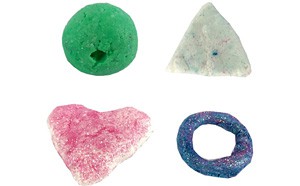Summary
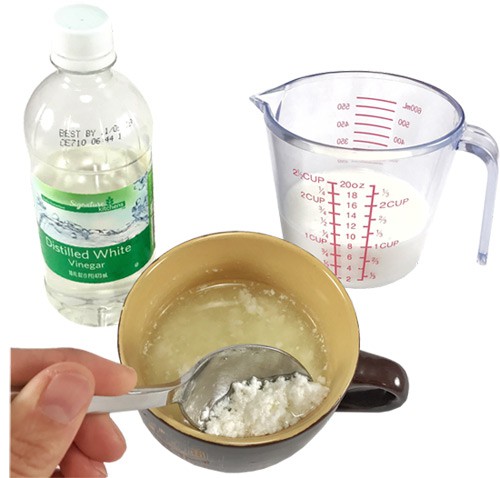 Image Credit: Svenja Lohner, Science Buddies / Science Buddies
Image Credit: Svenja Lohner, Science Buddies / Science Buddies
Overview
Teach your students how to make plastic out of milk in this hands-on lesson plan! You will conduct a simple milk-transforming experiment to explore how plastics can be derived from a natural resource such as milk. Students will perform their own experiments and can even create a product from their resulting organic casein polymer.Learning Objectives
- Explain what plastic, or a polymer, is made of on a microscopic/molecular scale
- Describe how the polymerization reaction can change the properties of a substance
- Reflect on the consequences of using natural resources for industrial purposes
NGSS Alignment
This lesson helps students prepare for these Next Generation Science Standards Performance Expectations:- MS-PS1-2. Analyze and interpret data on the properties of substances before and after the substances interact to determine if a chemical reaction has occurred.
- MS-PS1-3. Gather and make sense of information to describe that synthetic materials come from natural resources and impact society.
|
Science & Engineering Practices
Asking Questions and Defining Problems.
Ask questions that arise from careful observation of phenomena, models, or unexpected results, to clarify and/or seek additional information.
Constructing Explanations and Designing Solutions. Apply scientific ideas, principles, and/or evidence to construct, revise and/or use an explanation for real-world phenomena, examples, or events. |
Disciplinary Core Ideas
PS1.A: Structure and Properties of Matter.
Substances are made from different types of atoms, which combine with one another in various ways. Atoms form molecules that range in size from two to thousands of atoms.
Each pure substance has characteristic physical and chemical properties (for any bulk quantity under given conditions) that can be used to identify it. PS1.B: Chemical Reactions. Substances react chemically in characteristic ways. In a chemical process, the atoms that make up the original substances are regrouped into different molecules, and these new substances have different properties from those of the reactants. |
Crosscutting Concepts
Structure and Function.
Structures can be designed to serve particular functions by taking into account properties of different materials, and how materials can be shaped and used.
Connections to Engineering, Technology and Applications of Science Influence of Science, Engineering and Technology on Society and the Natural World. The uses of technologies and any limitation on their use are driven by individual or societal needs, desires, and values; by the findings of scientific research; and by differences in such factors as climate, natural resources, and economic conditions. Thus technology use varies from region to region and over time. |
Materials
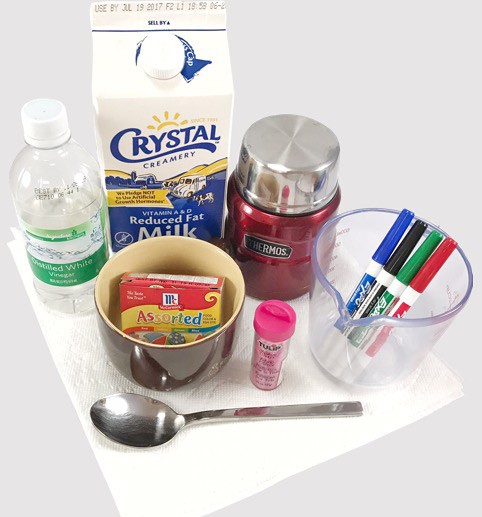 Image Credit: Svenja Lohner, Science Buddies / Science Buddies
Image Credit: Svenja Lohner, Science Buddies / Science Buddies
Materials for teacher preparation:
- Measuring cup (1)
- Milk (enough for each group of students to have 1 cup)
- Stovetop oven and pan (1) or microwave and microwaveable container (1)
- Thermos or insulated container big enough to hold all the hot milk
- White vinegar
- A variety of items that are made from plastic as demonstration objects
Materials per group of 2–4 students:
- Work surface that is safe to get damp
- Prepared hot milk (1 cup)
- Styrofoam® or other heat-resistant cup
- White or distilled vinegar (4 tsp.)
- Paper towels (6)
- Spoon (1)
- Optional: food coloring, glitter, or markers
Background Information for Teachers
This section contains a quick review for teachers of the science and concepts covered in this lesson.Plastic products are all around us. They are all similar in that they are made up of molecules that are repeated over and over again in a chain called a polymer. Polymers can be chains of one type of molecule, or chains of different types of molecules linked together in a regular pattern as shown in Figure 1. In a polymer, a single repetition of the pattern of molecules is called a monomer (even if the polymer is made up of only one type of molecule). The process of making a polymer is called polymerization, which describes the transformation of many individual monomer molecules into large chains or three-dimensional networks. There are many types of polymers, each having a different look or feel depending on what they are made of. Synthetic polymers are man-made and derived from materials such as oil, whereas natural polymers occur in nature and are made of renewable materials such as cellulose from wood or starch. A collective key property of all plastics is that they can be molded into many shapes. How different plastics behave and which products they are used for depends on the molecules they are made of. The name of the plastic also gives information about its chemical structure. For example, the name "polystyrene" (which Styrofoam® is made of) means many ("poly") of "styrene", which is the monomer of this polymer. Polypropylene (PP), on the other hand, is made of many repeat units of propylene.
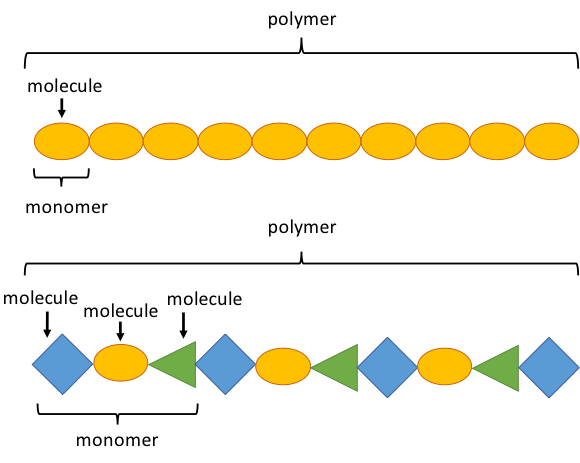 Image Credit: Svenja Lohner, Science Buddies / Science Buddies
Image Credit: Svenja Lohner, Science Buddies / Science Buddies
Figure 1. Polymers are made up of repeated patterns of molecules, called monomers. Monomers can be made up of one type of molecule (such as the top polymer) or multiple different molecules (such as the bottom polymer).
What does milk have to do with polymers? Besides water, fat, and lactose, milk contains many proteins called casein (case-een). Normally, the caseins form spherical shapes to stay in solution, but these spheres can easily be changed, and once changed, cannot re-form into spheres. For example, when milk is heated and combined with an acid, such as vinegar, the casein molecules undergo polymerization and unfold into long chains, forming curd. Each casein molecule is a monomer and the chain of casein monomers is a polymer—a natural plastic is created! The polymer can be scooped up and molded, which is why plastic made from milk is called casein plastic. From the early 1900s until about 1945, galalith, a casein plastic made with the chemical formaldehyde, was quite common. It has been used to make buttons, decorative buckles, beads and other jewelry, fountain pens, the backings for hand-held mirrors, and fancy comb and brush sets (Figure 2).
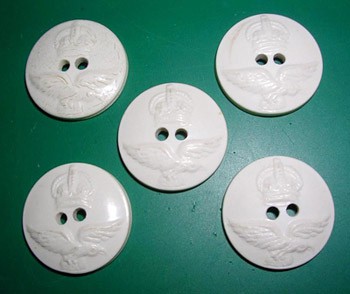 Image Credit: wikimedia user Tyranny Sue / Creative Commons Attribution-ShareAlike 3.0 Unported
Image Credit: wikimedia user Tyranny Sue / Creative Commons Attribution-ShareAlike 3.0 Unported
Figure 2. Buttons made from galalith, a casein plastic made from milk and formaldehyde. (Image credits: by Tyranny Sue, via Wikimedia Commons)
In this lesson plan, students will conduct their own polymerization experiment and use hot milk, vinegar, a cup, paper towels, and a spoon to make their own casein plastic.


